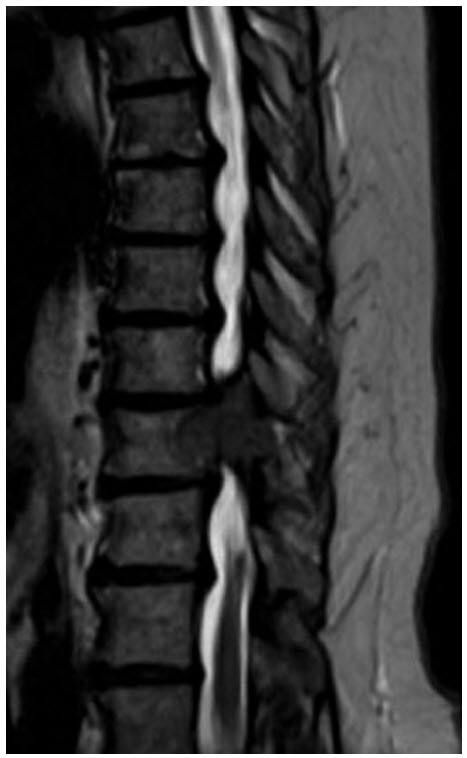Question 5#
A 71-year-old woman presents with a 2-week history of progressive numbness, tingling, and weakness in bilateral lower extremities. An MRI is obtained and reveals the findings below:

Which of the following regarding diagnosis and treatment of this lesion is TRUE?
A. Dexamethasone reduces neurologic impairment and spinal painB. Radiotherapy is very effective for renal, thyroid, non–small-cell lung, and gastrointestinal cancers
C. Surgery is contraindicated in the presence of spinal instability
D. CT myelography should be performed if allergy to gadolinium is present
E. Cervical segments are most commonly involved with cord compression due to spinal metastasis
Correct Answer is A
Comment:
Correct Answer: A
Spinal metastases frequently occur in cancer and compression of the spinal cord can occur when tumor extends into the epidural space. Diagnosis is confirmed by imaging, and MRI with gadolinium is the gold standard modality with up to 100% sensitivity in detection of cord compression. When contrast is not used, tumor may still be detected (D). For patients who cannot undergo MRI, CT myelography is the next best option. Compression occurs in the thoracic, lumbar, and cervical segments in 60%, 25%, and 15% of cases, respectively (E).
Treatment of malignant cord compression is directed toward palliation and cure. Glucocorticoids have been demonstrated to reduce neurologic impairment and pain (A). Radiotherapy is a good option for hematologic tumors such as lymphoma and myeloma which are characteristically radiosensitive. On the contrary, non–small-cell lung cancer and renal, thyroid, and gastrointestinal cancers, as well as sarcoma and melanoma, are relatively radioresistant and are generally treated with surgery (B). Radiotherapy is not an effective treatment for spinal instability, thus surgical correction should be pursued (C).
References:
- Loblaw DA, Mitera G, Ford M, Laperriere NJ. A 2011 updated systematic review and clinical practice guideline for the management of malignant extradural spinal cord compression. Int J Radiat Oncol Biol Phys. 2012;84:312-317.
- Ropper AE, Ropper AH. Acute spinal cord compression. N Engl J Med. 2017;376(14):1358-1369.
- Switlyk MD, Hole KH, Skjeldal S, et al. MRI and neurological findings in patients with spinal metastases. Acta Radiol. 2012;53:1164-1172.